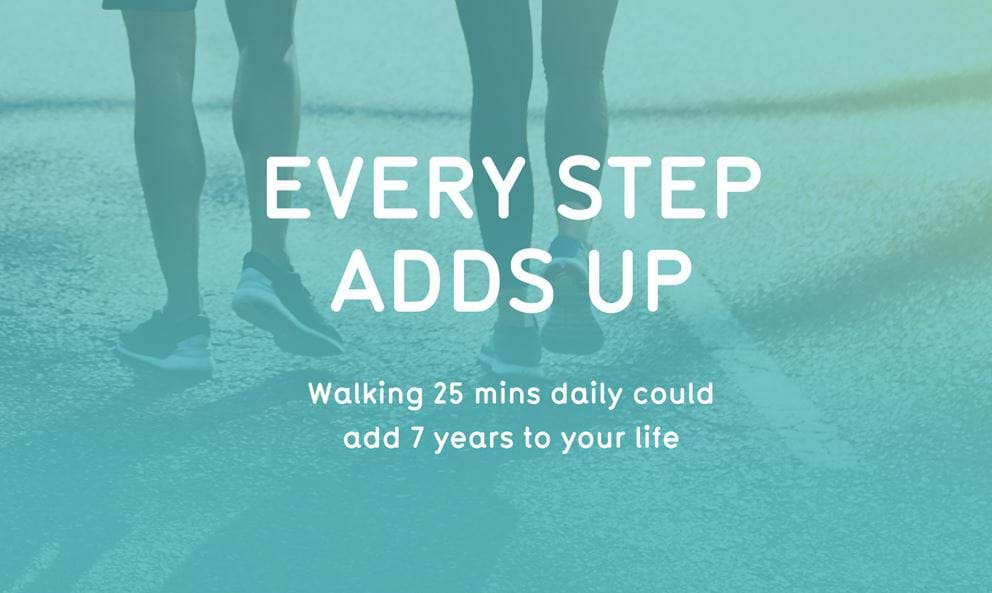A guide to walking your way to weight loss

Walking is one of those things which we all do, but which almost none of us do enough of. It’s a fundamental part of human fitness.
Biologically speaking, we’re still the same creatures which evolved thousands of years ago to form hunter-gatherer societies – and the need to move around is hardwired into us.
Today, many of us work from offices, and get the bus, train or car to wherever we need to go.
When it comes to the world of fitness, walking tends to get some of the least respect and attention of any form of exercise. As if it was just a lazy alternative to running.
But when all is said and done, there are some seriously good reasons – both for your weight loss efforts and general fitness and wellbeing – why you should start walking more, today.
Walking combats aging and can add seven years to your life
How’s that for a benefit?
Research presented at the European Society of Cardiology (ESC) followed 69 subjects between the ages of 30 and 60, and found that moderate exercise, including a brisk walk, yielded anti-aging benefits that could extend life by 3-7 years per person.[1]
And while you’re likely to benefit from this anti-aging effect through your regular workout, there’s nothing to suggest that adding some extra strolls to your daily routine wouldn’t enhance the benefits further.
Getting up for a regular walk might just keep you younger, and alive, for longer.
When you’re walking, you’re not sitting – and that might save your life
It’s a little-known fact that sitting for extended periods of time is one of the unhealthiest things you can do to yourself.
A 2015 meta-analysis published in the Annals of Internal Medicine found that sitting for 8 or more hours a day increased Type II Diabetes risk by 90%, and also significantly increased the risks of heart disease, various cancers, and all-cause mortality (in other words, your overall risk of death).[2]
That’s all pretty horrifying stuff, especially considering that so many of us spend our days sitting in front of a PC or TV screen.
But at least if you get your evening gym session in you won’t have to worry about all that, right?
Nope, afraid it’s still a problem. According to the American Heart Association, your gym session isn’t enough to offset the harm done by all that sitting around.[3]
Fortunately, though, there is a straightforward way of fighting back against those health risks. You guessed it; it’s by getting up and walking around.
One 2015 study from the US found that getting up and walking around for even 2 minutes each hour could extend your lifespan by up to 33% compared to those who stay seated.[4]
A short walk each day may be enough to promote fat loss and keep the pounds off
HIIT sprint training is a great way to shed the pounds, but just because you don’t break a sweat on a short walk doesn’t mean it’s not doing a good a job of promoting weight loss, too.
One study comparing the effects of a 30-minute daily walk (plus diet), a 60-minute daily walk (plus diet), and dieting alone, concluded that the 30 minute and 60 minute walks both yielded roughly the same benefits for weight loss. Blood pressure was also lowered, in addition to various other health benefits.[5]
In this study, both lengths of walk were found to be superior for weight loss and overall health than merely dieting alone.
What’s more, research has shown that there’s a clear correlation between low-level physical activity throughout the day and a healthier BMI – with women who averaged 60 minutes of moderate physical activity each day gaining significantly less weight over an extended period of time than those who didn’t.[6]
Not only can going for a daily walk be the perfect complement to your overall fat loss efforts, but it may even you prevent you getting to the point where you need to shed the pounds in the first place.
So, how can you fit a walk into your daily routine?
There are many ways of fitting a walk into your daily routine so that you can begin reaping the benefits immediately.
The first and most obvious way to get more walking done is to commute by foot if you live within walking distance of your job. Failing that, you can still add some walking to your regular commute by parking a bit further away from your office and walking the rest of the way, or by walking to a nearby café, park or restaurant to enjoy your lunch, instead of hanging around the office or catching the bus into town.
If you have a busy family life, consider adding a regular walk in the afternoon, when everyone’s home, and take your kids or partner along with you. That way you all get some exercise together while enjoying some bonding time.
Or, if you prefer to spend some alone time first thing in the morning, why not go out for an early morning walk in a safe area? You’ll get the day started with a clear head, and you can enjoy listening to the sounds of the world waking up around you. If you’d prefer, you could load an audiobook or playlist onto your phone and let your imagination carry you along.
For more tips on how to sneak movement into your life, check out Wellbeing articles.
[1] http://www.independent.co.uk/life-style/health-and-families/health-news/a-daily-walk-can-add-seven-years-to-your-life-10478821.html
[2] http://annals.org/aim/article/2091327/sedentary-time-its-association-risk-disease-incidence-mortality-hospitalization-adults
[3] http://www.medicalnewstoday.com/articles/312356.php
[4] https://www.ncbi.nlm.nih.gov/pubmed/25931456
[5] https://www.ncbi.nlm.nih.gov/pubmed/12439651
[6] http://jamanetwork.com/journals/jama/fullarticle/185585


